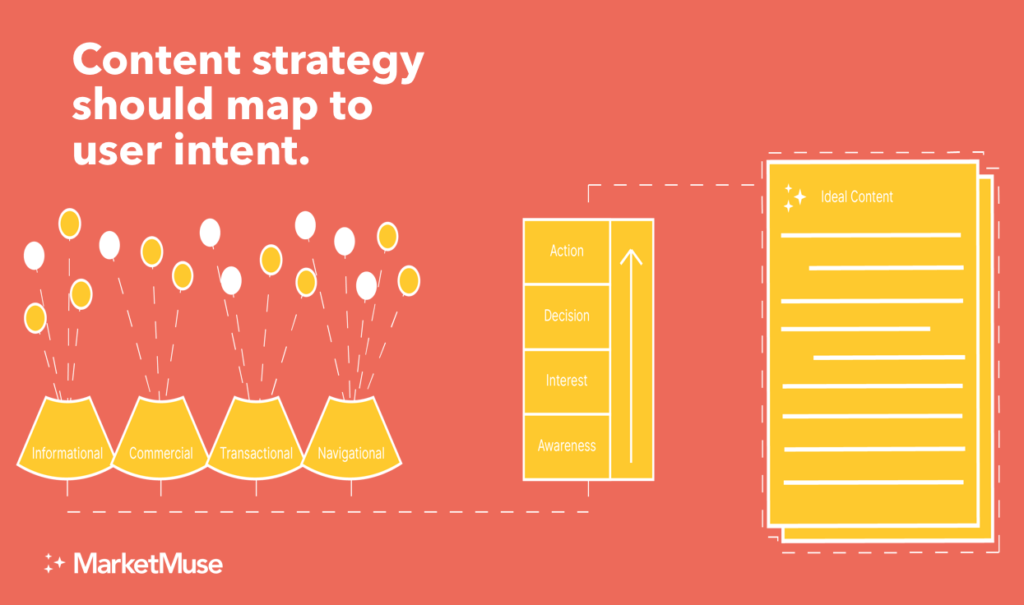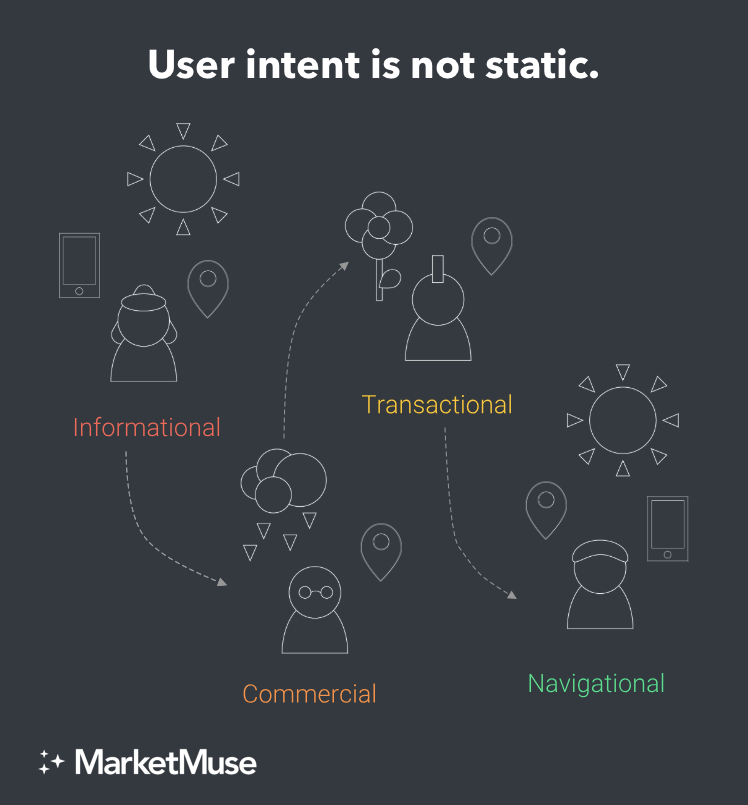How to Gain Greater Insight With User Intent Profiling
One of the most difficult aspects of content marketing is creating great content at scale. Creating great content? Not a problem given enough time and resources.
Producing content at scale? There’s no shortage of people willing to push massive amounts of content at bargain basement prices, so long as you’re not concerned about quality.
But there’s another obstacle that’s perhaps even more challenging. How do you prioritize and govern the process at scale?
Most content marketing teams use keyword volume and link metrics when making strategic and competitive content decisions. Typically, they look for keywords with high volume and little competition.
The problem is that they’re approaching keywords in isolation. Content isn’t just about matching and managing keywords. Search engines understand user intent and topics.
Why User Intent Profiling is Like Buyer Personas on Steroids
Every marketer should be familiar with buyer personas. Some may even have advanced to using the jobs-to-be-done framework.
User intent profiling will take you to the next level in understanding your audience and creating content that meets their needs. It’s crucial now that search engines understand intent.
Intent, context, and relevance are the glue that connects keywords to topics.
Context is a set of facts or circumstances that surround a situation or event. Intent is the purpose, plan and desired outcome of an action. Relevance is the state of being closely connected or appropriate.
So, you need to start asking:
- “What are the goals of my audience and what tasks do they want to accomplish?”
- “Why would my audience want this content?”
- “What stage of the funnel are they in?”
- “How does it relate to other topics my audience cares about?”
- “How explicit is the intent of this search query?”
Unfortunately, keywords don’t always tell you what your audience wants.
Google has Been Challenging Keyword-driven Content for Years
Here’s the thing.
It’s been years since Google moved away from its dependency on keywords. In this environment, for content to compete, it needs to move beyond targeting a single keyword.
Not only do you need to cover an entire topic, but you must also connect it with the intent of your audience.
After all, it’s 2019, and things have changed!
Back in 2010 Google’s Panda update played a crucial role in improving the quality of search results. Thin content got decimated overnight, leaving big brands reeling. Quality assessments became a favorite topic as organizations scrambled to recover all that lost organic traffic.
“Only an SEO walks into a bar, a dive, a speakeasy. Nobody links to that!”
Jeff Coyle, Co-founder& Chief Product Officer, MarketMuse
Another significant update occurred a few years later in 2013 with the Hummingbird update. This brought a visible change in Google’s results pages with the appearance of the answer box, cards and featured results output. Behind the scenes, there was a significant shift toward intent. Relevance rose to the top of the SERPs in an effort to match user intent.
Two years later in 2015, Google’s RankBrain update saw relevance and context play a more significant role in search results. The search engine began using AI-powered semantic and syntactic analysis to match content to searcher intent. Visually, “people also ask” boxes were introduced at this time.
What we couldn’t see was the emphasis Google started placing on user behavior, specifically searcher task completion. In other words, the search engine began rewarding content that enabled searchers to accomplish whatever caused them to search in the first place.
So, if someone enters the search phrase “content strategy infographic” your content needs to be an infographic on content strategy if it’s to match that intent. That person is looking for a specific type of infographic, not a blog post telling them about the benefits of infographics. Providing the appropriate infographic, in this case, allows the searcher to complete their task.
These days, although they roll out the occasional major update, “each day, Google usually releases one or more changes” focused on improving search results.
In the Pre-Panda world, content marketers could write keyword-driven content and meet their traffic goals. But post-Hummingbird, content marketers need to think like content strategists to satisfy users and maintain rankings.
5 Steps to Implementing User Intent Profiling in Your Content Strategy

- Determine which potential topic clusters will result in ROI if created.
- Evaluate existing content to improve context, relevance, and match user intent.
- Discover additional intents that are relevant to your business goals.
- Include every subtopic and related topic in your content, so it’s comprehensive.
- Turn that research into content briefs that provide actionable instructions to writing staff.
The primary benefit of user intent profiling is that it turns the pool of keywords you want to target into a content strategy that maps to intent and search/buyer journey.
There are four basic types of intent (information, commercial, transactional, and navigational) that are typically associated with four points in the buyer journey (awareness, interest, decision, and action). Although purchase intent gets a lot of attention, all intents connect to different positions in the funnel and require unique content format and narrative.
Trigger words and modifiers can be a first step in creating a profile (ex. best deals on, refurbished, shop online, buy [keyword] online). Core and plural keywords with no modifiers are also a good source (ex. Buy, cost, price, affordable, cheap, coupon, free shipping, “city,” near me).
3 Ways to Incorporate User Intent Into Your Content Strategy
If you’re eager to get started integrating user intent within your content strategy, you have three choices:
- Good: Pure Topical Content Strategy
- Better: SEO-Driven Strategy
- Best: A topical, intent-segmented, content and SEO strategy
The last one is the most robust and offers the greater opportunity to benefit from an increase in organic search traffic. Once you segment modifiers by intent, you can start grouping keywords by content type. You can map intent to existing content and identify gaps in your inventory.

Let’s take the topic “content marketing strategy” as our example. Here are a few search terms exhibiting informational intent:
- content marketing strategy definition
- define content marketing strategy
- content marketing strategy tips
- content marketing strategy framework
- content marketing strategy plan
There are many more that can be classified as a search for solutions and examples. For instance, here are some terms focused on a specific medium:
- video content marketing strategy
- mobile content marketing strategy
- online content marketing strategy
- digital content marketing strategy
This group is based on the type of business:
- b2b content marketing strategy
- branded content marketing strategy
- news-based content marketing strategy
Yet another group is based on content format:
- content marketing strategy example
- content marketing strategy
- sample content marketing strategy guide
- content marketing strategy outline
- content marketing strategy template
- content marketing strategy checklist
- content marketing strategy worksheet
- content marketing strategy pdf
- content marketing strategy infographic
A Simple Way to Get Started With User Intent Targeting
A basic strategy frequently used for intent targeting involves focusing on SERP features when they align with your business goals.
When examining the SERP, look for special features like:
- “People also ask”
- Answers (featured snippets)
- App download
- Images
- Knowledge Graph
- News
- Places
- Shopping
- Videos

Then check your inventory to determine how well your content aligns with the intent displayed in that SERP.
Get Started Today With User Intent
There’s no time like the present to get started on producing content that satisfies user intent. Here are a few things to keep in mind:
- Keyword strategies are not about synonyms
- A proper keyword strategy is predicated on creating a topical map of your niche. That map will help you grow your site to become authoritative, expert, and trustworthy.
- Identify the user intent, then set about satisfying that intent
- Algorithms no longer match search queries to keywords on a web page. Rather they are tuned to satisfying user queries by answering questions.
- This does not mean you should phrase your pages as questions and answers. Instead, try to understand the user intent and construct content that it satisfies the user intent implicit in the keyword phrase.
- Integrate user experience into your keyword strategy.
Remember, web pages rank because websites link to those pages. Websites link to those pages because those pages solved a problem because it scratches an itch. Nobody ever linked to a web page because of its keyword relevance.
People link to a site because of positive user experiences. View your keyword list through the framework of user intent. Then consider how the resulting content can be used to create a positive user experience.
What you should do now
When you’re ready… here are 3 ways we can help you publish better content, faster:
- Book time with MarketMuse Schedule a live demo with one of our strategists to see how MarketMuse can help your team reach their content goals.
- If you’d like to learn how to create better content faster, visit our blog. It’s full of resources to help scale content.
- If you know another marketer who’d enjoy reading this page, share it with them via email, LinkedIn, Twitter, or Facebook.
Stephen leads the content strategy blog for MarketMuse, an AI-powered Content Intelligence and Strategy Platform. You can connect with him on social or his personal blog.
